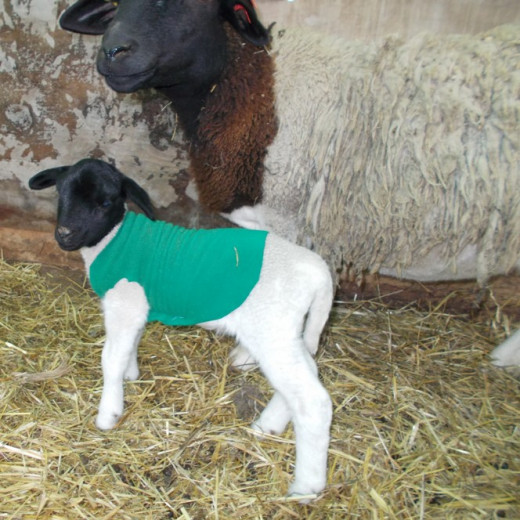As the weather starts to get colder, we all know that winter is coming. You may be one of those weird, unique people who actually enjoy the season. We don't.
Well, we enjoy looking outside at the beautiful snow, but don't enjoy being out in it. Having animals means we spend a lot of time outside in the winter making sure the animals are well looked after.
We lamb in winter, for reasons I'll explain below. This is a very exciting, but also stressful time. Our ram has been running with the ewes since mid-August, so considering that sheep have a five month gestation, we are now about halfway to lambing season.

Why Lamb in Winter?
Ideally, all lambs and kids would be born either on pasture in the summer, or in a warm barn if they are born in the winter. The truth is, many lambs and goat kids are born in the wintertime because of the needs of the market. In order to have lambs for Easter, and other holidays, the lambs need to be born early in the year. Purebred breeders who are raising show lambs for open shows, or 4-H projects also need early January lambs to be competitive.
See, the show world starts their lamb classes on January 1st each year. Ewe and Ram lambs are shown against other lambs born the same year, and a lamb born in early January should have a size advantage over a lamb born in mid-May. Even when it comes to yearlings, an early born lamb will probably be bigger than one born later, though this difference is less marked.
We also find that lambing in the winter gives the lambs a better start, because we can get them on 24/7 creep feed and keep them in a more controlled environment. This will ensure they are strong and healthy before they go out to pasture and are exposed to the parasites that are present in some quantity on most pastures.
Of course, there is also the instance where the ram smashed out of the solid pen that was supposed to hold him and bred a few ewes before you wanted, and you are now faced with lambing in the winter.
Truthfully, most lambs will actually do fine in cold weather, even in extreme cold. They just need to be wind-sheltered, have lots of bedding to lay in, and get enough milk from their mother. Below are a few more tips to help make sure your lambs survive the cold.
Housing Tips
Lambing in a warm, well-insulated barn is the ideal situation. This doesn’t mean the barn is heated, it means there is enough insulation to allow the animals to keep the building warm with their body heat. There should be some sort of provision made for ventilation. A stuffy, humid barn is the worst possible housing for livestock and will result in a lot of disease. Ideally, have a barn that keeps a consistent temperature above freezing.
Heat lamps can help if you install them properly over your lambing pens. I personally don’t like this option as I’ve heard of way too many barn fires being started by a heat lamp. It can also scorch the ewe’s back if it isn’t hung up high enough. Follow the manufactures instructions for hanging the lamp. Use appropriate extension cords if you require those. For safety, I recommend ALWAYS using OUTDOOR cords in the barn. Barns are known for being humid, and sometimes downright wet. An indoor cord might not safely withstand the trials of a barn and may short when you least expect. Never scrimp on cheap electrical products for your barn!
Coats can be purchased from some livestock supply stores. Some are made of real wool and designed as a single use item. Coats are also easy to make from polar fleece. Just make sure that they are sewn in such a way that the lamb won’t urinate on them. A wet lamb is a cold lamb.
The lambs need to be able to bury up to their necks in bedding when they lie down. Straw is ideal. Provide lots and lots of it. As lambing season progresses, add more bedding as necessary to keep the bedding pack clean and dry. Realize that looks can be deceiving when it comes to bedding. If you are wondering if the bedding is actually dry, kneel on it for several minutes. If you knee gets wet, the bedding is wet and you need to add more.

Other Tips
Dry lambs soon after birth. If it’s really cold, and/or the mother isn’t licking the lamb off quickly, rub it dry with a towel.
Ensure lambs get adequate colostrum. The lamb needs to be warmed from the inside out, and the nourishment will help get its own body heat going.
Ensure lambs get enough milk. Sometimes a lamb will look strong and healthy at the beginning, then fade all of a sudden. This might mean the mother has mastitis, or just a lack of milk, or that she’s rejected the lamb. Keep checking on the lambs to make sure they are actually eating. A fed lamb has a slightly rounded belly, is wet inside the mouth, and is content. A hungry lamb usually seems distressed, but not always.
Ensure ewes are in good shape before lambing. Get the ewes up to date on vaccines, deworming, and vitamins before lambing. You want the lambs in tip top shape when they hit the ground so they are strong enough to withstand inclement weather.
Later on I'll explain how to assess individual lambs to ensure they are doing well after birth.